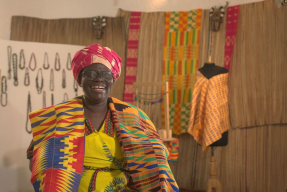In Defense of “High” MFI Interest Rates: Part II
February 14, 2011By Nila Uthayakumar, KF 14, Uganda
On the one-year anniversary of Eva Wu’s blog post entitled In Defense of “High” MFI Interest Rates, I was inspired to write a post on this exact topic. The date of this post is a coincidence, as I was actually inspired by the concerns of a group of friends I met with last week. They inundated me with questions: Why is it that microfinance institutions (MFIs) all over the world charge interest rates between 30 to 60% or even higher in many cases? Are they all predatory organizations, profiting from the hard earned money of the world’s working poor? How are these astronomical interest rates even remotely justifiable?
As they asked me these questions, I found that I was repeating myself in answering them. It is expensive to run an MFI. There are bad roads and very high transportation costs, it is time consuming to make visits to borrowers, borrowers often do not have collateral and loans are given to solidarity groups whose members guarantee each other’s loans, and borrower default is also a problem. These are but a handful of the issues that make microlending very different from traditional banking. Still, as I explained, I was not convinced myself. I wanted to see some numbers.
I am currently supporting a Kiva field partner based in Kampala, Uganda called MCDT. MCDT charges its borrowers 2.5% monthly interest or 30% interest per year, plus other fees. With the fees added to the interest rate, the portfolio yield (interest income earned plus fees divided by the total loan portfolio) is 64.5% per year. Does that figure shock some of you? It was difficult for even me to wrap my head around why my MFI needs to charge that much to its borrowers to stay in business, and I am in Kampala working in the middle of it all. A quick check of MCDT’s budget clarified that question for me. Here is the breakdown:
Currency is given in Ugandan Shillings on the left and US Dollars on the right. The exchange rate used is 2,358.49 USh to the US dollar.
| Income Earned in 2010 | 406,975,610.00 USh | $172,558 |
| (from Interest and Fees) | ||
| Expenses in 2010 | ||
| Salary and Staff Benefits | 159,446,175.00 USh | $67,605 |
| Telephone | 6,904,453.00 USh | $2,927 |
| Stationary | 14,446,840.00 USh | $6,125 |
| Office Expenses | 6,541,500.00 USh | $2,774 |
| Professional Fees | 3,136,000.00 USh | $1,330 |
| Staff Travel and Transport | 37,117,800.00 USh | $15,738 |
| Staff Travel Abroad | 5,554,940.00 USh | $2,355 |
| Bank Charges* | 1,652,594.00 USh | $701 |
| Utilities | 10,153,443.00 USh | $4,305 |
| Maintenance and Repairs | 1,709,300.00 USh | $725 |
| Computer Expenses | 3,642,300.00 USh | $1,544 |
| Staff Welfare and Recreation** | 16,922,870.00 USh | $7,175 |
| Board Expenses | 4,022,800.00 USh | $1,706 |
| Committee Expenses | 4,969,750.00 USh | $2,107 |
| Office Rent | 15,006,000.00 USh | $6,363 |
| Staff Medical Fund | 3,429,400.00 USh | $1,454 |
| Staff Training | 1,566,900.00 USh | $664 |
| Interest Expenses*** | 25,393,723.00 USh | $10,767 |
| Insurance Expenses | 7,440,881.00 USh | $3,155 |
| Audit Fees | 6,500,000.00 USh | $2,756 |
| Legal Expenses | 130,000.00 USh | $55 |
| Subscription | 546,500.00 USh | $232 |
| Consultancy | 9,200,000.00 USh | $3,901 |
| Annual General Meeting | 7,300,600.00 USh | $3,095 |
| Monitoring and Evaluation | 3,010,000.00 USh | $1,276 |
| Foreign Currency Exchange loss | 13,179,965.00 USh | $5,588 |
| Amortization | 2,226,000.00 USh | $944 |
| Provision for Bad Debts | 8,052,045.00 USh | $3,414 |
| Members’ Training Expense**** | 3,553,900.00 USh | $1,507 |
| TOTAL EXPENSES | 382,756,679.00 USh | $162,289 |
| Income Earned in 2010 | 406,975,610.00 USh | $172,558 |
| Total Expenses | 382,756,679.00 USh | $162,289 |
| Profit | 24,218,931.00 USh | $10,269 |
* MCDT banks with commercial banks. They have savings and checking accounts, and also make wire transfers, etc.
**This includes employee severance packages, a basic lunch for the staff, gifts of appreciation for employees during the Christmas season, and similar staff morale expenses.
***Although Kiva’s loans are interest free, MCDT works with other sources of funding that do charge them interest (i.e. Stromme Foundation)
****MCDT is a Savings and Credit Cooperative (SACCO), which means each of its borrowers are considered members and own shares in the company. The members are trained in business strategies and are given support as long as they are MCDT borrowers.
So, after all of MCDT’s expenses are covered, they are left with about $10,000 in profit, which they use to expand their business and make more loans to people who do not have access to affordable credit. There were a total of 15 employees at MCDT in 2010, which makes the average salary $4,507.
I’ll let the numbers speak for themselves and let you draw your own conclusions.
Special thanks to MCDT for access to the figures. How’s that for transparency.
Nila has just arrived in Kampala, Uganda after having spent six months in Zanzibar, Tanzania last year. She considers East Africa home now, and looks forward to working with several Kiva partner microfinance institutions throughout the next few months in Uganda and Kenya.
PREVIOUS ARTICLE
First Borrower Visit (Take 350+) →NEXT ARTICLE
Part 4: What is the industry doing to protect borrowers? →














